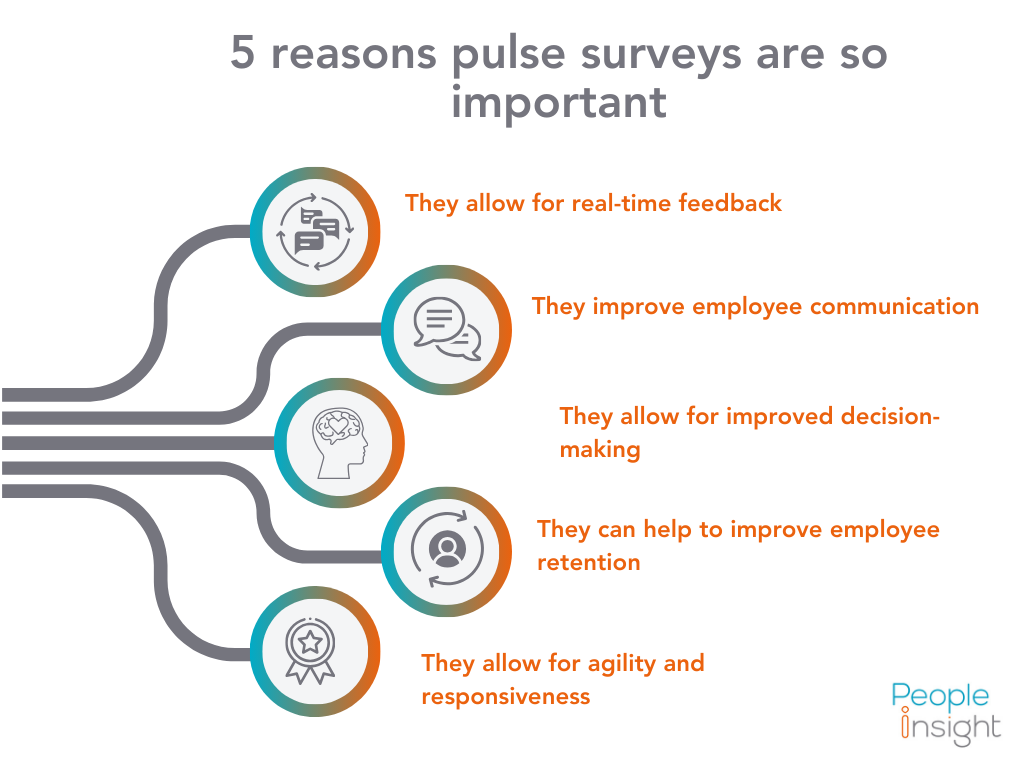
We want our employees to feel engaged. We want them to be heard — we care about the employee voice and, increasingly, business leaders around the world are coming to understand how important it is to really listen to employee sentiment. While informal channels, such as manager-employee catch ups, are incredibly important, more structured employee listening tools such as employee surveys offer a wealth of data. This data can help us get to grips with the employee experience and see what needs to be improved. As the saying goes, knowledge is power — and when you’re armed with more knowledge, you’re better equipped to bring about meaningful organisational change.
So the question becomes — how often should you be surveying your employees? Too frequent, and people become frustrated and disengaged with the whole process. But survey them too infrequently, and you don’t get an accurate, up-to-date picture of how your employees really feel about life at your company.
This is where pulse surveys come in. Pulse surveys offer a really effective, straightforward way for organisations to gather real-time feedback from their employees. Used in the right way, they’re a great tool to complement a forward-thinking, agile business. But let’s get back to basics and look at pulse surveys in more detail — what is a pulse survey? How can they be used to bring about change and what are some common pitfalls that hinder progress?
Download our guide on how to create great pulse surveys
A pulse survey is a short, focused survey designed to gather regular feedback from employees on specific aspects of their experience at work. Unlike more traditional staff surveys, which aim to be more comprehensive, pulse surveys are quick and typically consist of just a handful of questions. These surveys are usually sent out at regular intervals, such as monthly or quarterly, and focus on particular areas like employee wellbeing, work-life balance or leadership effectiveness.
The purpose of a pulse survey is to take the “pulse” of your workforce, providing real-time insights into their feelings and experiences. This allows companies to act quickly on feedback, addressing any issues before they become larger problems. By keeping pulse surveys brief and frequent, businesses can maintain an ongoing conversation with their employees and create an environment where their voices are regularly heard.
Pulse surveys offer businesses several important advantages, which is why they have become such a popular element in most employee listening strategies. Here are some key reasons why we recommend pulse surveys:

Pulse surveys provide immediate insights into employee sentiment, helping businesses stay ahead of potential issues and address concerns before they escalate.
By asking for regular feedback, pulse surveys help create an open line of communication between employees and management. This helps to create a culture of transparency and trust.
Regular feedback helps companies make more informed, data-driven decisions about workplace policies, training and development initiatives.
By identifying and addressing dissatisfaction early, pulse surveys can help prevent issues that might otherwise lead to employee turnover. An engaged workforce is more likely to stay long-term.
In a fast-changing work environment, pulse surveys allow organisations to remain agile, quickly responding to employee concerns and adjusting strategies as needed.
Learn more about the benefits of a pulse survey
Implementing pulse surveys is a great way to gather meaningful feedback from employees, but to maximise their effectiveness, you need to approach them with a clear strategy.
Here are some best practices to keep in mind when rolling out pulse surveys in your organisation:
Employees are more likely to engage with short surveys. Aim for 5-10 targeted questions that focus on specific aspects of employee experience. This will ensure you get meaningful data without overwhelming your staff.
Make sure the questions you ask are clear and straightforward. Ambiguity can lead to confusion and wholly inaccurate responses — in a later section, we’ll cover some good questions to use in your next pulse.
It’s important to maintain consistency in your survey cadence. Monthly or quarterly surveys are common for pulse surveys. Too frequent surveys may lead to survey fatigue, while too few can mean missed opportunities for feedback. Find a balance that works for your team.
For pulse surveys to be effective, employees need to feel comfortable giving honest feedback. Anonymity is crucial to encourage openness and transparency in responses.
Let your employees know why you’re conducting the survey. Create a survey communication strategy. Make it clear that the goal is to improve the workplace and that their feedback will be used to make tangible changes. This helps them understand the importance of their responses and encourages participation.
The most important aspect of pulse surveys is what you do with the feedback. After gathering the data, create a post-survey action plan and take concrete actions to address the issues raised by employees. Follow up with employees to share what changes are being made based on their feedback. This will demonstrate that their opinions matter.
To design an effective pulse survey, it’s important to ask questions that provide meaningful insights into the employee experience. Some examples of effective pulse survey questions include:
These questions focus on key areas of employee engagement and provide valuable data that can help businesses improve their workplace culture and increase employee satisfaction.
While pulse surveys are a valuable tool, it’s easy to make mistakes that can limit their effectiveness. Here are some common pitfalls to avoid:
Sending out too many surveys in a short period of time can overwhelm employees and cause them to disengage. It’s important to find a survey cadence that works for your organisation. Too many surveys can lead to declining participation rates, so be strategic in how often you ask for feedback.
One of the biggest mistakes companies make is collecting feedback without taking action. If employees feel like their responses go ignored, they’re less likely to participate in future surveys. When implementing pulse surveys, make sure you follow up and show that their feedback has led to real changes.
If your survey questions are too vague or irrelevant to employees’ daily work, you risk getting useless or unclear responses. Avoid generic questions like “How do you feel about the company?” and focus on specific areas such as “Do you feel supported in your role?” or “Is your workload manageable?”
Anonymity is key to getting honest feedback. If employees feel that their feedback could be traced back to them, they may hesitate to provide honest answers, especially if they are concerned about negative repercussions. Always make your pulse surveys anonymous to encourage candid feedback.
While it’s tempting to use complex survey platforms with too many features, simplicity often works best. An overly complicated survey tool can make it harder for employees to complete the survey and may lead to incomplete responses. It’s best to stick with a user-friendly, intuitive survey tool like People Insight that makes the process as simple as possible.
Avoiding these mistakes will help you run more successful pulse surveys that truly reflect employee sentiment and drive improvements in the workplace.
Choosing the right pulse survey platform is just as important as designing the survey itself. The platform you use should make it easy to distribute surveys, analyse results and track employee engagement over time. Here are a few key features to consider when selecting an employee pulse survey tool:
The survey tool should be intuitive and easy for both employees and managers to use. A simple, straightforward interface will encourage participation and ensure that you get accurate data. Employees shouldn’t feel burdened by the process.
Your pulse survey tool should allow for customisation so you can tailor the questions to suit your organisation’s specific needs. Whether it’s adjusting the survey’s appearance, modifying question types, or targeting specific departments, the flexibility to customise is important.
A good pulse survey tool will offer real-time analytics that help you quickly interpret the data. The ability to view results as they come in allows managers to act fast and address any immediate concerns. Look for tools that provide actionable insights, rather than just raw data — as an example, our generative AI Prism instantaneously analyses an incredible amount of data to offer actions to be taken. Not to mention, our HR consultants are always at the ready to provide assistance.
It’s important to choose a tool that employees can easily access from any device — whether it’s a desktop, tablet or mobile phone. You want to make sure pulse surveys are convenient for employees to complete, regardless of where they are working from.
As mentioned, anonymity is key to getting honest feedback. Make sure the survey tool has built-in features to protect the identity of respondents. Look for a platform that assures confidentiality and security, so employees can feel comfortable being open and honest in their responses.
If your organisation uses other HR software for tracking employee performance or engagement, consider a survey tool that integrates safely and seamlessly with these platforms. Integration can help streamline the data analysis process and provide a more comprehensive view of employee sentiment.
Once the results are in, the real value of a pulse survey comes from taking action. Analyse the feedback, identify any common themes or areas of concern and communicate with your employees about the changes that will be made based on their input. This shows your employees that their feedback matters and that your company is dedicated to continuous improvement.
Regularly conducting pulse surveys and responding to feedback helps maintain a culture of engagement and openness within your organisation. By actively addressing employee concerns, you build trust and create an environment where employees feel heard and valued.
If you want to create a more engaged workforce, it’s time to start using pulse surveys in your organisation. At People Insight, we specialise in crafting employee surveys that deliver meaningful, actionable insights. Contact us today to learn how we can help you build a stronger workplace culture through employee feedback.